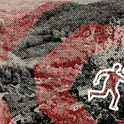Whatever happened to Karl Marx Stadt? In my childhood the East German city had the strangest name on the map of Europe. Was it as bleak as it sounded? Did you have to be a Marxist to live there? If you visited, would they let you out again? I longed to go, but then the Berlin wall came down and Karl Marx Stadt disappeared. The city didn’t really disappear, of course, but its inhabitants voted to restore its original name, Chemnitz. Now, 20 years after reunification, I went to see what had happened to this workers’ paradise. Before the second world war, Chemnitz was part of a triangle of dynamic Saxon cities, along with Dresden and Leipzig. But during the cold war, while those two cities held their own, Karl Marx Stadt was left behind. It’s at the end of a single line of railway track that runs from Leipzig. The contrast between Leipzig’s huge, busy central station and the Chemnitz terminus is stark. With its quiet concourse and deserted platforms, getting off the train in Chemnitz feels like stepping into the past. Chemnitz was flattened by Allied bombers in 1945 and rebuilt in robust brutalist style. Nearly 90 per cent of the old city centre had been destroyed, and the Soviets stripped away what was left (they even took the tram lines back to Russia), freeing space for the windswept squares that socialist town planners adore. Bland tower blocks rose out of the medieval rubble, marooned by endless boulevards. The city’s new name was another stroke of bad luck. The new town of Eisenhuttenstadt had been earmarked for the honour, but when Stalin died it became Stalinstadt instead. Marx never set foot in Chemnitz—it was renamed in 1953 mainly because of its status as the Saxon Manchester (it was a textile powerhouse in the 19th century). A huge bronze bust of Marx—a present from the USSR in 1971—looms over the city centre. “Working men of all countries unite,” proclaims a mural above his head. The people of Karl Marx Stadt dumped the name, but voted to keep the statue. Ironically, in 1989 Karl Marx Stadt was paralysed by demonstrations against the communist regime. Within a few weeks the wall was down and the residents of Chemnitz were free to travel. And travel they did—the city’s population shrank as its young people went west. In 2006 it became the city with the world’s lowest birth rate. But since the millennium, Chemnitz has been enjoying a discreet revival. Its population is just 250,000 but unemployment is under 15 per cent, well below the average in the former GDR. Siemens and Volkswagen have opened factories, drawing on talent from the technical university. The city has one of Germany’s best growth rates, albeit from a small base. New buildings by starchitects like Helmut Jahn have begun to fill in the empty spaces. Checking into the high-rise Kongress Hotel, I was hit by the solitude. The broad plazas below were built for crowds but there is hardly anyone about. Like the fascist structures of the 1930s, communist construction makes you feel insignificant, irrelevant—like an ant—and drives people off the streets. The highway around the city is equally vainglorious. Lone cars roar unhindered down the wide roads. Outside the old town hall I meet Stefan Weber, the city’s night watchman. We climb to the top of the tower where he shows me an intricate model of the old town. Compared to the new town below, it is utterly unrecognisable. Yet in the nooks between the modern monoliths, daily life endures. It’s market day and the cobbled square below is full of stalls and shoppers. Like a fan of an obscure football team, Stefan is stubbornly proud of his hometown. In a prettier city such patriotism might grate, but here his pride seems noble, almost heroic. Throughout the communist era he kept writing his address as Chemnitz. Out of such small subversions, revolutions grow. When the GDR finally fell apart, Stefan helped kickstart the campaign to reinstate the city’s old name. Chemnitz’s slogan is Stadt Der Moderne (city of modernity). At first I thought it was trying to make the best of a bad job. Yet the city boasts a wealth of modernist architecture. The leafy suburb of Kassberg is an oasis of art nouveau and the elegant Villa Esche sums up the city’s history. Built in 1902 for a cloth magnate, it was used by the red army and then the Stasi before becoming a gallery and museum. I wound up my weekend in the Tietz department store, established by a Jewish firm in 1910 and seized by the Nazis. It now houses a school and a library, as well as a gallery. The GDR-era art is locked in the cellar. You’re allowed to look, but it feels furtive, as if Chemnitz still doesn’t know what to make of this chapter of its past. On the train back to Leipzig, I passed an abandoned warehouse that bore the slogan: “All power to the five year plan!” This sign was probably less than 30 years old, yet it seemed a relic from a lost age. Karl Marx Stadt has had enough of five-year plans and revolutions. What it needs is normality. After the calamities of the 20th century, Chemnitz is starting to grow again.

Letter from Chemnitz
I’ve always wanted to visit Karl Marx Stadt. Twenty years after it disappeared, I finally did
June 22, 2010











